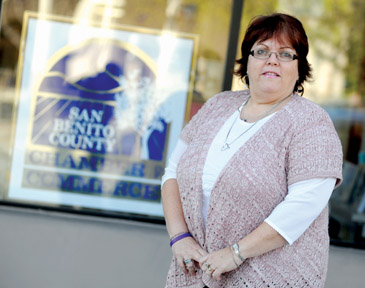A new plan to address the needs for more equitable broadband internet access in San Benito County was unveiled last week.
The San Benito County Broadband Strategic Plan was developed through a partnership between county officials, the Rural County Representatives of California (RCRC) and Virginia-based engineering company Teleworx. The plan was presented to the board of supervisors on Dec. 5.
The broadband strategic plan will serve as a roadmap to identify areas in the county that lack reliable internet, helping county officials address disparities in access. Funding for the project came from a grant by the Economic Development Administration.
The plan’s objective is to create a comprehensive, countywide broadband strategy to address connectivity needs. It encourages local governments in the area to pursue public-private partnerships to invest in broadband infrastructure
According to the Federal Communications Commission, 95% of county residents have access to broadband internet. About 99.9% of these residents can get internet speeds higher than 100 megabytes per second, which the FCC considers a standard speed.
However, data compiled by the broadband strategic plan project shows that of the remaining 5% of overall residents are highly underserved.
Eighty percent of underserved locations in the county are in rural areas, including Aromas, Ridgemark and Tres Pinos. In order to expand the county’s broadband infrastructure and reach these areas, the plan recommends substantial investment and the creation of two fiber optic and three fixed wireless access projects. These projects would cost about $18.4 million, with potential funding coming from state and federal grants.
In recent years, equitable access to broadband has been a priority at the national, state and local levels.
Expanding Access
In July 2021, Gov. Gavin Newsom signed Senate Bill 156, the Broadband Trailer Bill, which allocated $6 billion to expand broadband access and infrastructure in the state. The bill’s goal was building the “middle mile” broadband infrastructure, a state-owned open-access network.
This network resembles a road system in which smaller, local streets connect to various highways. In this example, the middle mile infrastructure are the highways, or the midpoint to which the localities trying to connect to broadband must build their own “roads” to reach. The closer communities are to that middle mile highway, the less they need to spend on creating the infrastructure to reach it.
When SB 156 was passed, it was lauded as a crucial step toward connecting underserved communities. However, in August the California Department of Technology changed its map outlining which communities get middle mile infrastructure without a public process, according to a report by Electronic Frontier Foundation. This slashed the proposed 10,000 miles of fiber optic broadband cable to 8,300 miles.
“These uninformed cuts to critical infrastructure will drastically raise the cost of building high-speed, high-capacity internet networks in unserved and underserved neighborhoods. It also jeopardizes the funds these communities need to build these networks. These changes run counter to the purpose of S.B. 156 and all efforts to close the digital divide.” the report stated.
The state said the cuts were due to inflation and the high construction costs. In September, Newsom reversed course and announced that he would “divert funds from the January 2024 budget to universalize broadband services throughout California,” according to Liana Bailey-Crimmins, director of the California Department of Technology.
In June 2023, the Biden administration unveiled its own national initiative to expand broadband access. The Broadband Equity and Deployment bill (BEAD) is a $42 billion grant program aimed at providing reliable and affordable broadband internet access to all residents and small businesses in the country by 2030. California is among 19 states to which a $1 billion allocation would be granted.
While state and federal initiatives move at a glacial pace, localized efforts continue to address the equitable access gap.
In October of this year, the Monterey Bay Economic Partnership (MBEP) published a white paper titled “The State of Broadband in the Monterey Bay Region.”
MBEP was established to advocate for reliable and affordable internet service, according to its website. It has partnered with organizations such as The Central Coast Broadband Consortium and the Salinas Valley Broadband Authority to develop its Digital Equity Initiative.
The white paper makes recommendations on how to span the digital divide by raising awareness among area residents about the benefits of broadband for all aspects of their lives. These include improved education and healthcare available digitally.
The paper found that 52% of households in San Benito County are eligible for the federal Affordable Connectivity Program, but only 30% of those eligible households are taking advantage of the program.
Echoing the findings of the San Benito County Broadband Strategic Plan, MBEP has found that the geographic challenges of the region make access to broadband more difficult for some residents.
“The rural nature of numerous communities within the tri-county area has contributed to the limited or lack of the infrastructure needed for fiber technology, leaving many residential and commercial community members needing more reliable broadband service,” the paper says.
MBEP calls for a “hybrid model” solution to address the disparities in access for San Benito County, as well as Santa Cruz and Monterey County. This would require efforts to determine which method of broadband delivery is best suited for a particular area.
In San Benito County, the broadband strategic plan has developed a three-pronged approach to provide better access: broadband infrastructure, broadband policy and digital equity.
By pursuing partnerships with private internet service providers (Comcast is an example), the county can adopt a policy that is mutually beneficial. Informing the public about affordable broadband access through programs such as the Affordable Connectivity Program is another component.
For the next year, county officials will embark on a scoping process that involves public forums and seeking out private partners to commit to building infrastructure. Based on that, the current plan will be reviewed and updated in fall 2024.







